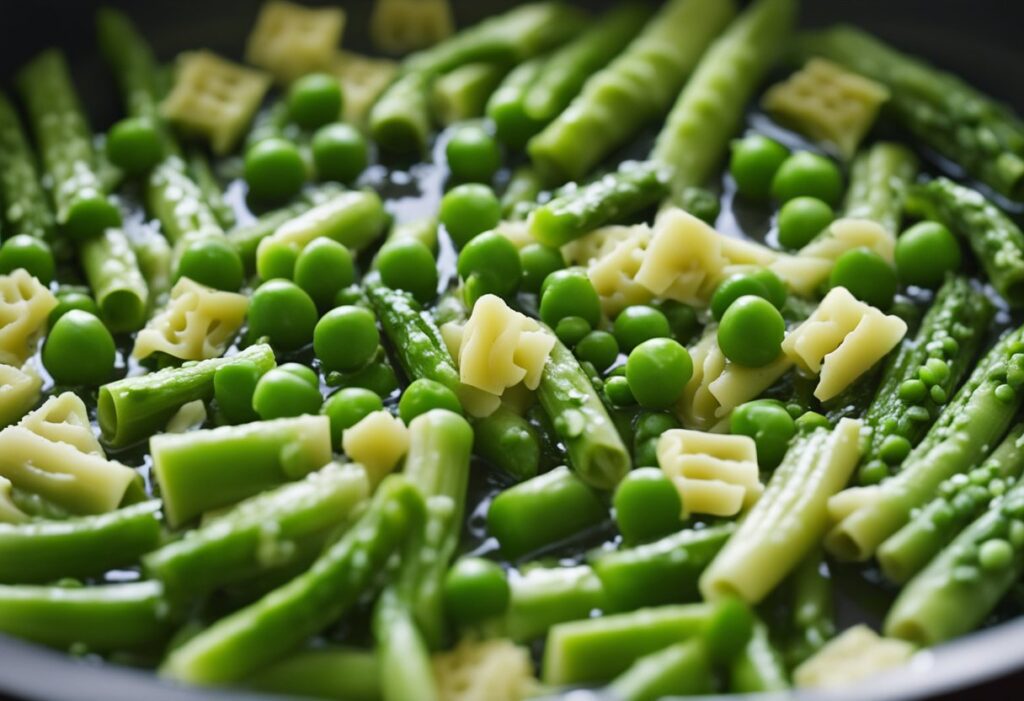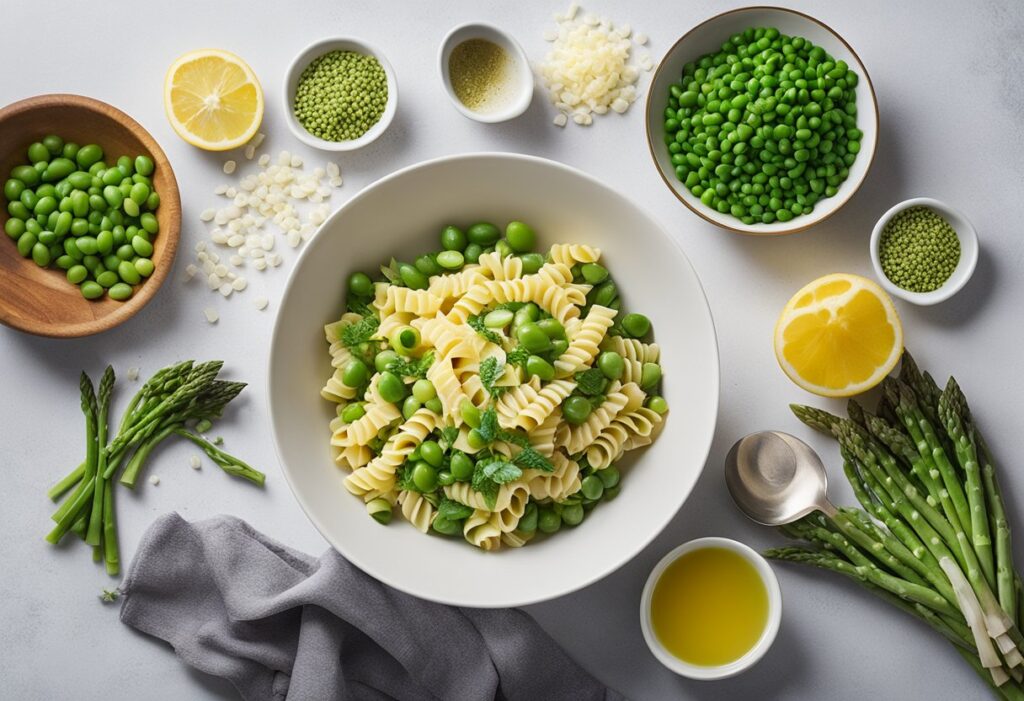Asparagus pea pasta salad offers a refreshing and nutritious option for any meal. This dish combines the delicate flavors of asparagus and sweet peas with pasta, resulting in a satisfying and colorful salad. This recipe not only highlights seasonal produce but also provides a simple and quick meal solution that everyone can enjoy.

Preparing asparagus pea pasta salad is straightforward, making it ideal for both seasoned cooks and beginners. The ingredients come together easily, creating a dish that is perfect for gatherings or a light lunch. The combination of textures and flavors makes it a delightful choice for those seeking something healthy yet tasty.
By incorporating fresh ingredients and a light dressing, this salad stands out as a versatile recipe that can adapt to various preferences. Whether served as a side dish or a main course, asparagus pea pasta salad is sure to impress anyone who tries it.
Overview of Asparagus Pea Pasta Salad
Asparagus pea pasta salad combines fresh ingredients and vibrant flavors, making it a popular choice for warm-weather meals. Its origins are rooted in Mediterranean cuisine, reflecting the use of seasonal vegetables. This dish also offers various health benefits, appealing to those seeking nutritious options.
Origins of Asparagus Pea Pasta Salad
Asparagus pea pasta salad draws inspiration from Mediterranean culinary traditions. The ingredients highlight the region’s emphasis on fresh produce, often enjoyed during spring and summer. Asparagus peas, also known as asparagus bean, are a variety of legume that originated in Asia but are now cultivated worldwide.
The combination of pasta with vegetables reflects a typical Mediterranean approach — balancing carbohydrates with nutritious ingredients. In many cultures, similar salads are frequently served as a side dish or light main course. Various regions have adopted and modified the dish, leading to numerous variations that highlight local produce and flavors.
Health Benefits
This pasta salad is packed with nutrients, providing several health benefits. It features asparagus, a low-calorie vegetable rich in vitamins A, C, E, and K. Asparagus contains antioxidants and is known for its anti-inflammatory properties.
Peas offer a good source of plant-based protein and fiber, contributing to digestive health. Additionally, this dish incorporates whole grain pasta options, which can enhance nutrient intake by providing complex carbohydrates.
Including colorful vegetables in the salad increases vitamin diversity, promoting overall wellness. Consuming fresh, whole food ingredients like those found in asparagus pea pasta salad supports a balanced diet and healthy lifestyle.
Discover also Ultimate Dense Bean Salad Recipe .
Essential Ingredients

When preparing asparagus pea pasta salad, selecting the right ingredients is crucial for achieving the best flavor and texture. The following components each play a significant role in the final dish.
Asparagus Selection
Choosing the right asparagus is vital for enhancing the salad’s taste. Look for fresh, vibrant green stalks with firm, closed tips. Thin stalks are more tender, while thicker ones can be slightly tougher but offer a heartier texture.
When purchasing, avoid any stalks that appear limp or have browning tips. Seasonal availability is also important; spring delivers the freshest asparagus, making it an ideal time to create this dish. Preparation involves snapping off the woody ends and optionally blanching or roasting for added depth of flavor.
Pasta Varieties
The type of pasta used can significantly influence the salad’s overall character. Short pasta shapes like farfalle, fusilli, or penne are excellent choices. They hold the dressing well and provide a pleasant mouthfeel.
Cooking the pasta to al dente ensures it remains firm and does not become mushy when combined with other ingredients. After cooking, rinse the pasta under cold water to stop the cooking process and cool it down quickly, making it a suitable addition to the salad.
Pea Types and Preparation
Peas are essential for adding sweetness and color to asparagus pea pasta salad. Sugar snap peas and English peas work particularly well. Sugar snap peas offer a crisp texture, while English peas provide a tender, sweet flavor.
Preparation is straightforward. For sugar snap peas, simply trim the ends and leave them whole. For English peas, shell them before cooking briefly in boiling water to enhance their sweetness. This step brightens their color and flavor, making them a delightful addition to the salad.
Additional Salad Components
To elevate the asparagus pea pasta salad, consider incorporating additional ingredients that complement the main components. Ingredients such as cherry tomatoes, bell peppers, or radishes can add vibrant color and crunch.
Herbs like basil or parsley are excellent for imparting freshness. A dressing made from olive oil, lemon juice, and Dijon mustard can tie the flavors together beautifully. Balancing these elements ensures a well-rounded and satisfying dish that is both nutritious and flavorful.
Kitchen Tools and Equipment
To prepare asparagus pea pasta salad, certain tools and equipment are essential for efficiency and ease.
Essential Tools
- Large Pot: For boiling pasta. It should be spacious enough to accommodate the pasta and water without overflowing.
- Colander: Used to drain the cooked pasta. A sturdy colander with fine holes prevents smaller pieces from escaping.
- Cutting Board: A stable surface for chopping vegetables and herbs. A wooden or plastic board works well.
- Sharp Knife: Necessary for cutting asparagus, peas, and other ingredients. A chef’s knife is recommended.
- Mixing Bowl: A large bowl for combining the pasta with dressing and other ingredients.
- Serving Spoon: Useful for tossing and serving the salad. A slotted spoon aids in serving without excess liquid.
Optional Equipment
- Salad Spinner: If rinsing vegetables, this tool helps remove excess water effectively.
- Food Processor: For quickly chopping larger quantities of vegetables or making dressings.
- Measuring Cups and Spoons: Important for accurate ingredient portions.
- Tongs: Helpful for mixing ingredients gently without mashing them.
Having these tools ready ensures a smooth cooking process and enhances the overall experience of making asparagus pea pasta salad.
Preparation Steps
Following precise preparation steps will yield a crisp, flavorful asparagus pea pasta salad. Attention to cooking techniques ensures optimal texture and transparency of flavors.
Cooking Pasta to Perfection
To achieve the ideal pasta for salad, start by choosing a short pasta like fusilli or penne. Bring a large pot of salted water to a boil. The salt enhances the pasta’s flavor. Add the pasta and cook according to the package instructions, usually around 8 to 10 minutes for al dente.
Stir occasionally to prevent sticking. When finished, reserve a cup of pasta water for later use. Drain the pasta and rinse it under cold water to halt cooking and cool it down. This will help maintain the pasta’s chewy texture in the salad. Allow it to drain completely before incorporating it with other ingredients.
Asparagus and Peas Cooking Techniques
For vibrant asparagus, trim the ends and cut it into 1-inch pieces. Blanch the asparagus in boiling water for 2-3 minutes until bright green, then transfer it to an ice bath immediately. This process ensures crispness and color retention.
Next, prepare the peas. Fresh peas can be blanched similarly for 1-2 minutes, while frozen peas only require a few minutes of boiling. Drain well and allow both vegetables to cool. Both ingredients will add freshness and a pop of color to the salad.
Mixing and Combining Ingredients
In a large bowl, combine the cooled pasta, asparagus, and peas. Drizzle with a dressing of olive oil, lemon juice, salt, and pepper. Use a spatula or large spoon to gently toss the mixture, ensuring even coating without mashing the ingredients.
Consider adding additional elements like cherry tomatoes or feta cheese for enhanced flavor. Adjust seasoning to taste. Once mixed, let the salad sit for at least 15 minutes to allow flavors to meld. This step enhances the overall taste profile and gives a well-rounded experience in every bite.
Dressing and Seasoning
A well-crafted dressing enhances the flavor of asparagus pea pasta salad, while proper seasoning balances its elements. The following details cover the creation of the dressing and how to achieve the right flavor profile.
Creating the Dressing
To prepare a flavorful dressing, combine extra virgin olive oil, lemon juice, and Dijon mustard. The basic ratio often recommended is 3:1 for oil to acid. For added flavor, consider mixing in minced garlic, herbs like basil or dill, and a hint of honey for sweetness.
Whisk the ingredients together until emulsified. Taste frequently to adjust acidity and salt levels. A pinch of salt and black pepper will help enhance the taste. For a creamier dressing, adding a dollop of Greek yogurt can create a smooth texture without overwhelming the dish.
Balancing Flavors
Balancing flavors is essential for a delightful pasta salad. Acid from lemon or vinegar brightens the dish, while richness from olive oil adds depth. Consider using fresh herbs to introduce aromatic notes.
To ensure the dressing complements the salad, taste the mixed salad before adding the dressing. It’s critical to adjust the seasoning based on the ingredients. If the salad contains rich flavors, reduce the acid slightly to avoid overpowering it. Conversely, a bland salad may benefit from a sharper dressing to elevate its taste.
Serving Suggestions
Asparagus pea pasta salad can be served in various ways to enhance its flavor and presentation. Here are some ideas:
- Chilled: Serve the salad cold for a refreshing dish, ideal for hot days or picnics.
- Warm: Gently reheat the salad for a comforting option. It can be enjoyed warm, especially during cooler months.
- As a Side Dish: Pair the salad with grilled chicken, fish, or tofu to create a well-rounded meal.
- Additions: Consider topping the salad with grated Parmesan, feta cheese, or toasted nuts like pine nuts or almonds for added flavor and texture.
- Herb Garnish: Fresh herbs, such as basil or parsley, can elevate the presentation and taste.
- Lemon Zest: A sprinkle of lemon zest just before serving adds brightness to the dish.
- Presentation: Serve in a clear bowl to showcase the colorful ingredients, attracting attention when dining.
- Serving Portions: Individuals can portion the salad into smaller bowls for easy serving at gatherings or potlucks.
These suggestions can help to enjoy asparagus pea pasta salad on various occasions, adapting it to different preferences and settings.
Storing and Shelf Life
Asparagus pea pasta salad can be stored effectively to maintain its freshness. Proper storage techniques will help preserve its flavors and texture.
Storage Guidelines
- Refrigeration: It should be kept in an airtight container in the refrigerator.
- Duration: When stored correctly, it lasts for up to 3-5 days.
Freezing
- Freezing Option: Freezing is not recommended due to the texture of ingredients like asparagus peas and pasta.
- Thawing: If frozen, it may become mushy upon thawing.
Signs of Spoilage
Look for the following indicators that the salad may have spoiled:
- Off Odor: A sour or unusual smell is a sign of spoilage.
- Texture Changes: Sliminess or excessive mushyness indicates deterioration.
- Color Changes: Noticeable discoloration means it is no longer fresh.
Best Practices
- Consume the salad within the recommended storage time for optimal taste.
- For leftovers, consider dividing into smaller portions to extend shelf life and maintain quality.

Asparagus Pea Pasta Salad
- Total Time: 30 minutes
- Yield: 4–6 servings 1x
- Diet: Vegetarian
Description
A refreshing asparagus pea pasta salad made with al dente penne, blanched asparagus, sweet peas, and cherry tomatoes. Tossed in a light lemon and olive oil dressing, it’s garnished with fresh herbs and optional Parmesan or feta. Perfect for a light, healthy meal.
Ingredients
- 250g penne pasta (or any short pasta like fusilli or farfalle)
- 200g fresh asparagus, trimmed and cut into 1-inch pieces
- 150g fresh or frozen peas (sugar snap peas or English peas)
- 10 cherry tomatoes, halved
- 2 tbsp extra virgin olive oil
- 1 tbsp lemon juice (plus extra lemon zest for garnish)
- 1 tsp Dijon mustard
- Salt and black pepper to taste
- Fresh parsley or basil for garnish
- Optional: grated Parmesan or feta cheese for serving
Instructions
Cook the pasta:Bring a large pot of salted water to a boil. Add the penne pasta and cook until al dente, according to package instructions. Drain and rinse with cold water to cool down. Set aside.
Blanch the asparagus and peas:In another pot, boil water and blanch the asparagus for 2-3 minutes until it turns bright green. Add the peas in the last minute if using fresh peas. Drain the vegetables and transfer them to an ice bath to keep their color and crispness.
Prepare the dressing:In a small bowl, whisk together the olive oil, lemon juice, Dijon mustard, salt, and black pepper. Taste and adjust the seasoning as needed.
Combine ingredients:In a large mixing bowl, combine the cooled pasta, asparagus, peas, and cherry tomatoes. Drizzle with the dressing and toss gently to coat all the ingredients evenly.
Serve:Garnish with freshly chopped parsley or basil, lemon zest, and optionally, grated Parmesan or crumbled feta. Serve chilled or at room temperature.
Notes
Let the salad sit for 10-15 minutes before serving to allow the flavors to meld.
- Prep Time: 15
- Cook Time: 15
- Category: Salad, Pasta
- Method: Boiling, Blanching, Mixing
- Cuisine: Mediterranean
Nutrition
- Serving Size: 1 cup
- Calories: 250 kcal
- Sugar: 5g
- Sodium: 200mg
- Fat: 10 g
- Saturated Fat: 1.5 g
- Unsaturated Fat: 8g
- Trans Fat: 0mg
- Carbohydrates: 30g
- Fiber: 4 g
- Protein: 8 g
- Cholesterol: 0mg

